Michael Greger's Blog, page 11
October 10, 2024
Exploring Mexican Cuisine with Alexa Soto

As an expert in Mexican cuisine with a plant-based twist, how have you found food to be an important part of your culture and how you share your culture with others?
The way I approach my passion for cooking is by going back to the indigenous roots of Mexican cooking, which is rooted in plants. Mexican cuisine at its core is abundant in nuts, seeds, legumes, vegetables, and fruits. I really enjoy highlighting ingredients that come from the earth through traditional dishes that celebrate my culture that is rich in joy, celebration, and pride.
When did you start cooking and developing your own recipes? How do you educate people about making beautiful Mexican dishes using plant-based ingredients? Are people ever surprised to learn your recipes are plant-based?
When I first explored a plant-based diet nearly ten years ago, I was 20 years old and living with my Mexican grandmother and my parents. It was a strange feeling, because while I felt pulled to learn to cook in a new way that led with plants and honored my morals, I also longed to hold onto my Mexican heritage through food. With many phone calls to family members, asking for recipes, traveling to different parts of Mexico, and becoming familiar with seasonal produce at my local farmers market, I found lots of inspiration. I have so much pure joy sharing my passion for food in a way that feels most authentic to me, and that’s highlighting plants and my culture at the same time! I really try to create food that either feels familiar to people or just brings overall excitement, with new innovative takes on classic Mexican recipes, so my community stays interested and excited to get in the kitchen.
What are some plant-based ingredients and/or vegan dishes that you’d like to highlight as part of Mexican food traditions? Anything you’d especially like people to know about these foods?
One of the most ancient dishes in Mexican cuisine that is naturally plant-forward is mole, a unique experience of endless flavorful layers, consisting of chilies, nuts, seeds, spices, herbs, dried fruits, chocolate, and tomatoes, making for a sweet, spicy, savory, and smoky luscious sauce. A sauce that is the main star of the dish, made with love and a long list of plant-based ingredients, whose roots lie in pre-Hispanic cooking techniques of the indigenous people. Typically, mole is served with chicken, but for a plant-based take, I love to serve it with roasted oyster mushrooms or crispy tofu, or kept simple with a few warm corn tortillas and a side of rice.
What do you envision as the way forward to encourage people to eat more fruits and vegetables and return to traditional Hispanic eating patterns?
It is important to explore true authentic Mexican dishes to truly honor and respect the diversity of this cuisine. To look beyond the dishes that are represented in America and, instead, explore regions of Mexico such as Oaxaca and Merida where there are several dishes that use indigenous cooking techniques and plant-based ingredients. One that comes to mind is the blending and grinding of nuts and seeds in sauces like mole or a Roasted Pumpkin Seed Dip (Sikil P’ak) native to Merida. These ancient techniques are now used frequently in plant-based cooking.
What does National Hispanic Heritage Month mean to you?
I honor my culture daily through food, language, music, and tradition, so to see others honor my culture rich in love and pride is really special to see. I am beyond proud of my heritage and happy to share it with the world in a more intentional way throughout the month of September!
Please tell us a little bit about your work and career.
I am a Mexican-American culinary enthusiast passionate about vegan Mexican cooking. I specialize in transforming traditional Mexican dishes into delicious plant-based versions, blending my rich cultural heritage with a modern, health-conscious twist. Over the past decade, I have shared my recipes, bits of my life, and deep care for mental health advocacy with my audience that has grown and become a community that feels like family!
Please tell us a little bit about your book.
A rich tapestry of traditional Mexican cuisine, reimagined with a plant-based twist to bring you simple, affordable, and nourishing vegan delights from the first light of morning to the sweet end of dinner. With my very own photography capturing the essence of each dish, Plantas is your heartfelt invitation to experience the cherished food of Mexican culture through a plant-based lens. It’s a celebration, an homage to the vibrant plants that are the cornerstone of the cuisine we’ve all come to adore!
Vegan Calabacitas con Crema
This delicious Vegan Calabacitas con Crema is my Abuelita’s creamy zucchini dish. It’s so satisfyingly delicious!
Serves 5-6
½ cup cashews½ yellow or white onion, thinly sliced3 zucchinis, halved lengthwise and sliced thin in half moons1 pint cherry tomatoes or 2 Roma tomatoes, diced½ – ¾ teaspoon miso paste3 garlic cloves, minced2 cups filtered waterPepper to tasteSmall handful of cilantro, chopped
Add the cashews to a bowl and cover with boiling water. Let soak for at least 15 minutes.In a large pan over medium heat, add the onions and sauté for 3 minutes, adding some water as needed.Push the onions to the edges of the pan, add the zucchini, and cook for 5 to 6 minutes. Add the tomatoes, miso paste, and minced garlic, and cook for another 5 to 6 minutes.Drain the cashews, then add them to a blender with the 2 cups of filtered water. Blend on high for 1 minute, until smooth.Add the cashew cream to the vegetables and mix. Season everything with pepper to taste and let it simmer on medium low for 5 to 6 minutes or until thickened. Garnish with chopped cilantro.Enjoy with tortillas or as a side!
For more from Alexa Soto, check out Fueled Naturally and @alexafuelednaturally on Instagram.
October 8, 2024
The Largest Study on Fasting in the World
The Buchinger-modified fasting program is put to the test.
A century ago, fasting—“starvation, as a therapeutic measure”—was described as “the ideal measure for the human hog…” (Fat shaming is not a new invention in the medical literature.) I’ve covered fasting for weight loss extensively in a nine-video series, but what about all the other purported benefits? I also have a video series on fasting for hypertension, but what about psoriasis, eczema, type 2 diabetes, lupus, metabolic disorder, rheumatoid arthritis, other autoimmune disorders, depression, and anxiety? Why hasn’t it been tested more?
One difficulty with fasting research is: What do you mean by fasting? When I think of fasting, I think of water-only fasting, but, in Europe, they tend to practice “modified therapeutic fasting,” also known as Buchinger fasting, which is more like a very low-calorie juice fasting with some vegetable broth. Some forms of fasting may not even cut calories at all. As you can see below and at 1:09 in my video The World’s Largest Fasting Study, Ramadan fasting, for example, is when devout Muslims abstain from food and drink from sunrise to sunset, yet, interestingly, they end up eating the same amount—or even more food—overall.

The largest study on fasting to date was published in 2019. More than a thousand individuals were put through a modified fast, cutting daily intake down to about ten cups of water, a cup of fruit juice, and a cup of vegetable soup. They reported very few side effects. In contrast, the latest water-only fasting data from a study that involved half as many people reported nearly 6,000 adverse effects. Now, the modified fasting study did seem to try to undercount adverse effects by only counting reported symptoms if they were repeated three times. However, adverse effects like nausea, feeling faint, upset stomach, vomiting, or palpitations were “observed only in single cases,” whereas the water-only fasting study reported about 100 to 200 of each, as you can see below and at 2:05 in my video. What about the benefits though?

In the modified fasting study, participants self-reported improvements in physical and emotional well-being, along with a surprising lack of hunger. What’s more, the vast majority of those who came in with a pre-existing health complaint reported feeling better, with less than 10 percent stating that their condition worsened, as you can see in the graph below and at 2:24 in my video.
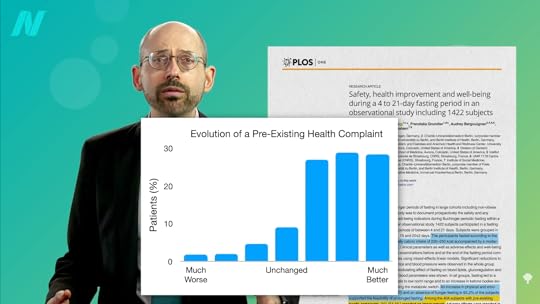
However, the study participants didn’t just fast; they also engaged in a lifestyle program, which included being on a plant-based diet before and after the modified fast. If only the researchers had had some study participants follow the healthier, plant-based diet without the fast to tease out fasting’s effects. Oh, but they did! About a thousand individuals fasted for a week on the same juice and vegetable soup regimen and others followed a normocaloric (normal calorie) vegetarian diet.
As you can see below and at 2:54 in my video, both groups experienced significant increases in both physical and mental quality of life, and, interestingly, there was no significant difference between the groups.

In terms of their major health complaints—including rheumatoid arthritis; chronic pain syndromes, like osteoarthritis, fibromyalgia, and back pain; inflammatory and irritable bowel disease; chronic pulmonary diseases; and migraine and chronic tension-type headaches—the fasting group appeared to have an edge, but both groups did well, with about 80 percent reporting improvements in their condition and only about 4 percent reporting feeling worse, as you can see below and at 3:25 in my video.

Now, this was not a randomized study; people chose which treatment they wanted to follow. So, maybe, for example, those choosing fasting were sicker or something. Also, the improvements in quality of life and disease status were all subjective self-reporting, which is ripe for placebo effects. There was no do-nothing control group, and the response rates to the follow-up quality of life surveys were only about 60 to 70 percent, which also could have biased the results. But extended benefits are certainly possible, given they all tended to improve their diets, as you can see below and at 4:00 in my video.

They ate more fruits and vegetables, and less meats and sweets, and therein may lie the secret. “Principally, the experience of fasting may support motivation for lifestyle change. Most fasters experience clarity of mind and feel a ‘letting go’ of past actions and experiences and thus may develop a more positive attitude toward the future.”
As a consensus panel of fasting experts concluded, “Nutritional therapy (theory and practice) is a vital and integral component of fasting. After the fasting therapy and refeeding period, nutrition should follow the recommendations/concepts of a…plant-based whole-food diet…”
If you missed the previous video, check out The Benefits of Fasting for Healing.
October 3, 2024
Can Fasting Be Healing?
Where did the idea of therapeutic fasting come from?
The story of life on Earth is a story of starvation. Ash from massive volcanoes and asteroids blocked out the sun, which killed the plants, which then killed almost everything else. As Darwin pointed out: “Thus, from the war of nature, from famine and death, the most exalted object which we are capable of conceiving” arose—namely, us.
“Among apes, humans are particularly well adapted to prolonged fasting.” Evolving in a context of scarcity is believed to have shaped “our exceptional ability to store large amounts of energy [calories] when food is available.” Of course, nowadays, our ability to easily pack on pounds is leading to modern diseases, like obesity and type 2 diabetes. But, without the ability to store so much body fat, we may not have made it to tell the tale.
Scarcity wasn’t just caused by the asteroids millions of years ago. “All of Upper Egypt was dying of hunger,” reads an inscription on an Egyptian tomb from about 4,000 years ago, “to such a degree that everyone had come to eating his children…” Just hundreds of years ago, “[p]arents killed their children and children killed parents” and ate them, and “the bodies of executed criminals were eagerly snatched from the gallows.” Hunger wiped out as many as two-thirds of the population of Italy and one-third of the population of Paris. So, we don’t have to go back to ancient history. “Even the most secure and affluent populations of today need only trace their history back a short distance to find evidence of famines that would have impinged on their forebears.” For example, there have been nearly 200 famines in Britain over the last 2,000 years.
Now, we tend to be suffering from too much food, which carries its problems, but “what about the consequences of not ever starving?” This was a question raised nearly 60 years ago. If our physiology is so well-tuned to periodic starvation, by eliminating that, might we be harming our overall well-being? We just didn’t know.
The lack of research in the area of starvation was attributed to the “difficulty of securing willing human subjects.” So, what little we had may have come from unwilling subjects. Physicians within the Warsaw Ghetto made detailed accounts before they succumbed, and Irish Republican Army prisoners in Northern Ireland starved themselves to death after hunger striking up to 73 days. However, starvation isn’t necessarily the same as fasting, an issue raised in medical journals more than a century ago. “Starvation is normally a forced, mentally stressful, and chronic condition, whereas [therapeutic] fasting is voluntary, limited in duration, and usually practiced by people in adequate nutritional state”—that is, individuals who start with adequate nutrition.
Therapeutic fasting? Where did we get this idea of fasting therapy? “Fasting for medical purpose”? As I discuss in my video The Benefits of Fasting for Healing, it may have originally arisen out of the observation that when people get acutely ill, they tend to lose their appetite, so maybe there’s something in the wisdom of our body to stop eating. That’s presumably where the whole “starve a fever” folklore came from.
There was a sense that “fasting affords physiologic rest” for the body—not just for the digestive tract, but throughout—allowing the body to concentrate on healing. It was evidently “an open secret” that veterinarians used to hospitalize dogs with “various dyspeptic and metabolic ailments” only to fast them back to health. So, the theory went, maybe it might work for people, too.
Beyond just freeing up all the resources that would normally be used for nutrient digestion and storage, there’s a concept that, during fasting, our cells switch over to some sort of protection mode. Why would fasting reduce free radical “oxidative damage and inflammation, optimize energy metabolism, and bolster cellular protection”? It’s the “that which doesn’t kill us makes us stronger” concept known as hormesis. That’s kind of the opposite of the “let the body rest” theory. It’s more like “let the body stress.” The stress of fasting may steel the body against other stresses coming our way. This was demonstrated perhaps most starkly in a set of cringe-worthy experiments in which mice were blasted with Hiroshima-level gamma radiation sufficient to kill 50 percent within two weeks, but of the mice who had first been intermittently fasted for six weeks before, not a single one died, as you can see in the graph below and at 4:33 in my video.
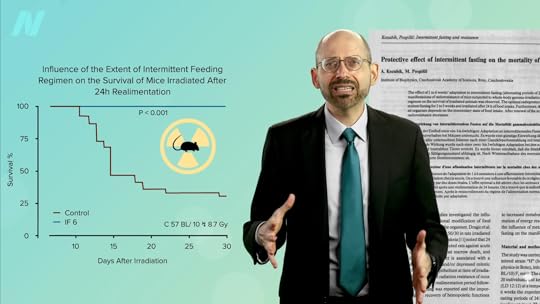
It’s these kinds of dramatic data that led to extraordinary claims like therapeutic fasting could drive half of all doctors out of business. You don’t know until you put it to the test, and we’ll explore that next.
There’s been an explosion in research interest in fasting over the last few years. Stay tuned for The World’s Largest Fasting Study.
Due to my work on How Not to Diet, I have discussed several studies in videos that are already available to you on fasting and weight loss. Check out the related posts below.
October 1, 2024
What’s the Best Weight-Loss and Disease-Prevention Diet?
The most effective diet for weight loss may also be the most healthful.
Why are vegetarian diets so effective in preventing and treating diabetes? Maybe it is because of the weight loss. As I discuss in my video The Best Diet for Weight Loss and Disease Prevention, those eating more plant-based tend to be significantly slimmer. That isn’t based on looking at a cross-section of the population either. You can perform an interventional trial and put it to the test in a randomized, controlled community-based trial of a whole food, plant-based diet.
“The key difference between this trial [of plant-based nutrition] and other approaches to weight loss was that participants were informed to eat the WFPB [whole food, plant-based] diet ad libitum and to focus efforts on diet, rather than increasing exercise.” Ad libitum means they could eat as much as they want; there was no calorie counting or portion control. They just ate. It was about improving the quality of the food rather than restricting the quantity of food. In the study, the researchers had participants focus just on a diet rather than exercising more exercise because they wanted to isolate the effects of eating more healthfully.
So, what happened? At the start of the study, the participants were, on average, obese at nearly 210 pounds (95 kg) with an average height of about 5’5” (165 cm). Three months into the trial, they were down about 18 pounds (8 kg)—without portion restrictions and eating all the healthy foods they wanted. At six months in, they were closer to 26 pounds (12 kg) lighter. You know how these weight-loss trials usually go, though. However, this wasn’t an institutional study where the participants were locked up and fed. In this trial, no meals were provided. The researchers just informed them about the benefits of plant-based eating and encouraged them to eat that way on their own, with their own families, and in their own homes, in their own communities. What you typically see in these “free-living” studies is weight loss at six months, with the weight creeping back or even getting worse by the end of a year. But, in this study, the participants were able to maintain that weight loss all year, as you can see below and at 1:57 in my video.

What’s more, their cholesterol got better, too, but the claim to fame is that they “achieved greater weight loss at 6 and 12 months than any other trial that does not limit energy [caloric] intake or mandate regular exercise.” That’s worth repeating. A whole food, plant-based diet achieved the greatest weight loss ever recorded at 6 and 12 months compared to any other such intervention published in the medical literature. Now, obviously, with very low-calorie starvation diets, you can drop down to any weight. “However, medically supervised liquid ‘meal replacements’ are not intended for ongoing use”—obviously, they’re just short-term fixes—“and are associated with ‘high costs, high attrition rates, and a high probability of regaining 50% or more of lost weight in 1 to 2 years.’” In contrast, the whole point of whole food, plant-based nutrition is to maximize long-term health and longevity.
What about low-carb diets? “Studies on the effects of low-carbohydrate diets have shown higher rates of all-cause mortality”—meaning a shorter lifespan—“decreased peripheral flow-mediated dilation [artery function], worsening of coronary artery disease, and increased rates of constipation, headache, halitosis [bad breath], muscle cramps, general weakness, and rash.”
The point of weight loss is not to fit into a smaller casket. A whole food, plant-based diet is more effective than low-carb diets for weight loss and has the bonus of having all good side effects, such as decreasing the risk of diabetes beyond just weight loss.
“The lower risk of type 2 diabetes among vegetarians may be explained in part by improved weight status (i.e., lower BMI). However, the lower risk also may be explained by higher amounts of ingested dietary fiber and plant protein, the absence of meat- and egg-derived protein and heme iron, and a lower intake of saturated fat. Most studies report the lowest risk of type 2 diabetes among individuals who adhere to vegan diets. This may be explained by the fact that vegans, in contrast to ovo- and lacto-ovo-vegetarians, do not ingest eggs. Two separate meta-analyses linked egg consumption with a higher risk of type 2 diabetes.”
Maybe it’s eating lower on the food chain, thereby avoiding the highest levels of persistent organic pollutants, like dioxins, PCBs, and DDT in animal products. Those have been implicated as a diabetes risk factor. Or maybe it has to do with the gut microbiome. With all that fiber in a plant-based diet, it’s no surprise there would be fewer disease-causing bugs and more protective gut flora, which can lead to less inflammation throughout the body that “may be the key feature linking the vegan gut microbiota with protective health effects”—including the metabolic dysfunction you can see in type 2 diabetes.
The multiplicity of benefits from eating plant-based can help with compliance and family buy-in. “Whereas a household that includes people who do not have diabetes may be unlikely to enthusiastically follow a ‘diabetic diet,’ a low-fat plant-based approach is not disease-specific and has been shown to improve other chronic conditions. While the patient [with diabetes] will likely see improvement in A1C [blood sugar control], a spouse suffering from constipation or high blood pressure may also see improvements, as may children with weight issues,” if you make healthy eating a family affair.
This is just a taste of my New York Times best-selling book, How Not to Diet. (As with all of my books, all proceeds I received went to charity.) Watch the book trailer. You may also be interested in its companion, The How Not to Diet Cookbook.
Check out my hour-long Evidence-Based Weight Loss lecture for more.
September 26, 2024
Can We Safely Use Melamine Dishes and Polyamide Plastic Utensils?
I recommend glass, ceramic, porcelain, or stainless steel tableware and wooden or stainless steel cooking utensils.
Melamine is used to make a variety of hard plastic “food contact items such as cups, plates, bowls, and utensils because they are dishwasher safe, inexpensive, and durable.” If that word sounds familiar, it may be because melamine has also been added illegally to protein products to game the system to make it appear that “food commodities” like pet food contain more protein than they actually do. By 2007, more than a thousand potentially contaminatedpet food products were recalled after “the chemical was found to be a contaminant in wheat gluten used in those products,” but not before it caused disease and death in pets throughout North America.
“It is presumed that melamine was intentionally added by suppliers in China to falsely elevate the measured protein content and, hence, the monetary value of these products.” The pet food scandal was just the writing on the wall. The following year, “melamine was discovered to be the cause of an outbreak of urinary tract stones and renal failure” (kidney stones and kidney failure), affecting hundreds of thousands of infants and young children throughout China. “Investigations revealed that the compound was added illegally to powdered milk and baby formulas to falsify protein content.”
As I discuss in my video Are Melamine Dishes and Polyamide Plastic Utensils Safe?, in the United States, you can find it in food packaging and sneaking its way into animal feed. However, those using melamine dishware can be exposed directly, as it migrates straight into the food upon exposure to heat. In fact, “cooking spoons and crockery made of melamine resin are not suited for microwaves and cooking,” according to food safety authorities. Okay, but what if you never cook with it, fry with it, or microwave it? What if you just use melamine to eat out of?
In “A Crossover Study of Noodle Soup Consumption in Melamine Bowls and Total Melamine Excretion in Urine,” researchers measured the amount of melamine flowing through the study subjects’ bodies compared to eating the same soup out of ceramic bowls. Their findings? “Melamine tableware may release large amounts of melamine when used to serve high-temperature foods”—and not even hot foods. “Melamine migration can be detectable from daily-use melamine-made tableware, even in the low temperatures,” like just warm water. Why do we care? Because the level of melamine you’re exposed to “is significantly associated with kidney function deterioration in patients with early-stage CKD,” chronic kidney disease, in which even relatively “low melamine levels may cause a rapid decline in kidney function.” So, I would suggest glass, ceramic, porcelain, or stainless steel tableware instead.
What about polyamide utensils, common black plastic spoons, spatulas, and the like? All sorts of different plastic materials are used in kitchen utensils. Polyamide is “typically used for turners [spatulas] or ladles due to their high heat and oil resistance.” “However, components of this plastic can migrate from the utensils into the food and consequently be ingested by consumers.” Out of 33 utensils tested, nearly 1 in 3 exceeded the upper safety limit. The German Federal Institute for Risk Assessment “recommends that consumers keep contact with food as brief as possible when using PA [polyamide] kitchen gadgets, especially at high temperatures,” such as above the temperature at which we may drink hot tea or coffee.
A different survey of black plastic kitchen utensils found about a third contaminated with flame retardant chemicals. Why? Because it may be made from plastic recycled from electronic equipment that was impregnated with the stuff. Then, should you dip the polyamide utensil into oil, the chemicals can trickle out, suggesting that using such “utensils for frying may lead to considerable dietary exposure.”
The black dye itself in some polyamide utensils can leach out, too. Eventually, with enough use, the levels drop, but it may take the equivalent of boiling the utensils for about a hundred hours before the dye leaking approaches safety levels. It’s probably just easier to use utensils that are wooden or stainless steel.
This is the last in a three-part series of cookware videos. If you missed the others, check out Are Aluminum Pots, Bottles, and Foil Safe? and Stainless Steel or Cast Iron: Which Cookware Is Best? Is Teflon Safe?.
It may not be safe to microwave melamine, but what about microwaving in general? See Are Microwaves Safe? and The Effects of Radiation Leaking from Microwave Ovens.
September 24, 2024
Is Stainless Steel or Cast Iron Cookware Best? Is Teflon Safe?
What is the best type of pots and pans to use?
In my last video, I expressed concerns about the use of aluminum cookware. So, what’s the best type of pots and pans to use? As I discuss in my video Stainless Steel or Cast Iron: Which Cookware Is Best? Is Teflon Safe?, stainless steel is an excellent option. It’s the metal chosen for use “in applications where safety and hygiene are considered to be of the utmost importance, such as kitchenware.” But what about studies showing that the nickel and chromium in stainless steel, which keeps the iron in stainless unstained by rust, can leach into foods during cooking? The leaching only seems to occur when the cookware is brand new. “Metal leaching decreases with sequential cooking cycles and stabilizes after the sixth cooking cycle,” after the sixth time you cook with it. Under more common day-to-day conditions, the use of stainless steel pots is considered to be safe even for most people who are acutely sensitive to those metals.
A little leaching metal can even be a good thing in the case of straight iron, like a cast iron skillet, which can have the “beneficial effect” of helping to improve iron status and potentially reduce the incidence of iron deficiency anemia among children and women of reproductive age. The only caveat is that you don’t want to fry in cast iron. Frying isn’t healthy regardless of cookware type, but, at hot temperatures, vegetable oil can react with the iron to create trans fats.
What about using nonstick pans? Teflon, also known as polytetrafluoroethylene (PTFE), “is used as an inner coating material in nonstick cookware.” Teflon’s dark history was the subject of a 2019 movie called Dark Waters, starring Mark Ruffalo and Anne Hathaway. Employees in DuPont’s Teflon division started giving birth to babies with deformities before “DuPont removed all female staff” from the unit. Of course, the corporation buried it all, hiding it from regulators and the public. “Despite this significant history of industry knowledge” about how toxic some of the chemicals used to make Teflon were, it was able to keep it hidden until, eventually, it was forced to settle for more than half a billion dollars after one of the chemicals was linked to “kidney and testicular cancers, pregnancy-induced hypertension, ulcerative colitis, and high cholesterol.”
“At normal cooking temperatures, PTFE-coated cookware releases various gases and chemicals that present mild to severe toxicity.” As you can see below and at 2:38 in my video, different gases are released at different temperatures, and their toxic effects have been documented.

You’ve heard of “canaries in the coal mine”? This is more like “canaries in the kitchen, as cooking with Teflon cookware is well known to kill pet birds,” and Teflon-coated heat lamp bulbs can wipe out half a flock of chickens.
“Apart from the gases released during heating the cooking pans, the coating itself starts damaging after a certain period. It is normally advised to use slow heating when cooking in Teflon-coated pans,” but you can imagine how consumers might ignore that. And, if you aren’t careful, some of the Teflon can start chipping off and make its way into the food, though the effects of ingestion are unknown.
I could find only one study that looks at the potential human health effects of cooking with nonstick pots and pans. Researchers found that the use of nonstick cookware was associated with about a 50 percent increased risk of colorectal cancer, but that may be because of what they were cooking. “Non-stick cookware is used in hazardous cooking methods (i.e. broiling, frying, grilling or barbecuing) at high temperatures mainly for meat, poultry or fish,” in which carcinogenic heterocyclic amines (HCA) are formed from the animal protein. Then, the animal fat can produce another class of carcinogens called polycyclic aromatic hydrocarbons (PAH). Though it’s possible it was the Teflon itself, which contains suspected carcinogens like that C8 compound from the movie Dark Waters, also known as PFOA, perfluorooctanoic acid.
“Due to toxicity concerns, PFOA has been replaced with other chemicals such as GenX, but these new alternatives are also suspected to have similar toxicity.” We’ve already so contaminated the Earth with it, though, that we can get it prepackaged in food before it’s even cooked, particularly in dairy products, fish, and other meat; now, “meat is the main source of human exposure” to these toxic pollutants. Of those, seafood is the worst. In a study of diets from around the world, fish and other seafood were “major contributors” of the perfluoroalkyl substances, as expected, given that everything eventually flows into the sea. Though the aquatic food chain is the “primary transfer mechanism” for these toxins into the human diet, “food stored or prepared in greaseproof packaging materials,” like microwave popcorn, may also be a source.
In 2019, Oral-B Glide dental floss was tested. Six out of 18 dental floss products researchers tested showed evidence of Teflon-type compounds. Did those who used those kinds of floss end up with higher levels in their bloodstream? Yes, apparently so. Higher levels of perfluorohexanesulfonic acid were found in Oral-B Glide flossers, as you can see below and at 5:28 in my video.
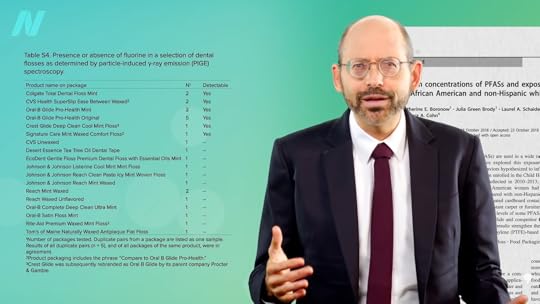
There are a lot of environmental exposures in the modern world we can’t avoid, but we shouldn’t make things worse by adding them to consumer products. At least we have some power to “lower [our] personal exposure to these harmful chemicals.”
This is the second in a three-video series on cookware. The first was Are Aluminum Pots, Bottles, and Foil Safe?, and the next is Are Melamine Dishes and Polyamide Plastic Utensils Safe?.
What about pressure cooking? I covered that in Does Pressure Cooking Preserve Nutrients?.
So, what is the safest way to prepare meat? See Carcinogens in Meat.
September 19, 2024
Can We Safely Use Aluminum Foil, Bottles, and Pots?
DNA damage is assessed in users of aluminum cookware.
“Over the last decades, the toxicity of aluminum for humans has been heavily discussed and is still not completely clarified.” Those occupationally exposed to aluminum—for instance, in smelter plants—suffer from oxidative stress and free radicals that can damage their DNA. What about just using aluminum cookware? Articles like “Metal Exposures from Aluminum Cookware: An Unrecognized Public Health Risk in Developing Countries,” suggesting an “unrecognized public health risk,” were limited to the developing world where “cookware is made in informal shops by casting liquid aluminum melted from a collection of scrap metal,” including the likes of vehicle radiators, lead batteries, and computer parts, which is how you can get so much lead leaching into people’s food.
Then “The Relationship Between Plasma Aluminum Content, Lymphocyte DNA Damage, and Oxidative Status in Persons Using Aluminum Containers and Utensils Daily” was published, suggesting that aluminum itself may be harmful. Most of our aluminum exposure comes from processed junk food containing aluminum additives, “including those within some processed cheeses, baking powders, cake mixes, frozen dough, and pancake mixes.” However, about 20 percent of the daily intake of aluminum may come from aluminum cooking utensils, such as “pans, pots, kettles, and trays.”
Might this cause a problem? Researchers took blood from consumers who used aluminum cookware versus those who did not and found that not only did the aluminum users have twice the level of aluminum in their blood, as you can see below and at 1:33 in my video Are Aluminum Pots, Bottles, and Foil Safe?, but they had more free radical damage of their body fats and proteins. What’s more, the total antioxidant capacity of the bloodstream of those using aluminum cookware was compromised, so they suffered significantly more DNA damage.

Indeed, as you can see below and at 1:52 in my video, those with the highest levels of aluminum in their blood tended to suffer significantly more damage to their DNA. No surprise, since “aluminum is considered to be a pro-oxidant agent.”
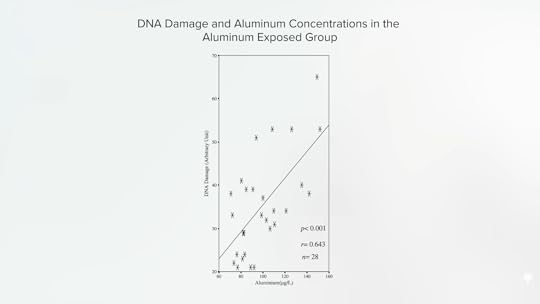
These folks weren’t just casually using aluminum pots, though. Specifically, they use them every day to cook and store acidic foods, like yogurt and tomato sauce, which can leach out more aluminum. But, even using “camping dishes,” which tend to be aluminum since it’s so light, for just one week, could greatly exceed the tolerable weekly intake guidelines, especially for children, if you incorporated something acidic, like marinating a fresh catch in lemon juice. Once in a while won’t make much difference, but these findings suggest that you may not want to cook in aluminum day in and day out.
What about aluminum drinking bottles? They’re nice and light, but children drinking two cups a day of tea or juice from them could exceed the tolerable aluminum exposure limit. So, out of an abundance of caution, safety authorities like the German Federal Institute for Risk Assessment “recommend that consumers avoid the use of aluminum pots or dishes for acidic or salted foodstuffs such as apple sauce, rhubarb, tomato puree, or salt herring…thus prophylactically avoiding the ‘unnecessary ingestion’ of aluminum.”
What about aluminum foil? Wrapping and baking food in aluminum foil is a common culinary practice. The concern is that this could represent “a potentially hazardous source of aluminum in the human diet.” When put to the test, there was leakage of aluminum from the foil to the food, but the amount was so small that it would be more of an issue for small children or those suffering from diminished kidney function.
What about just wrapping food in foil to store it in the refrigerator? Only marginal increases in aluminum are seen—except when the food is in contact with the foil and, at the same time, certain other types of metal, such as stainless steel, which is largely iron. That sets up a battery and “can lead to tremendous food aluminum concentrations.” For example, as you can see below and at 4:34 in my video, the aluminum levels in a ham before and after a day coveredin foil are negligible; there’s hardly a bump in the foil-covered ham. But, if that same foil-wrapped ham sits on top of a steel tray or serving plate for a day, the aluminum levels in the ham shoot up.

Finally, you know how aluminum foil is often glossy on one side and dull on the other? Which would be worse? Fish fillets were baked and grilled both ways, wrapped with the glossy side out versus the dull side out, and no significant difference was found.
This is the first in a series of three videos on cookware. Stay tuned for Stainless Steel or Cast Iron: Which Cookware Is Best? Is Teflon Safe? and Are Melamine Dishes and Polyamide Plastic Utensils Safe?.
I’ve discussed aluminum in antiperspirants, food, medications, and tea. Check out the related posts.
September 17, 2024
Is Creatine Safe and Efficient for High Homocysteine?
Those on a healthy plant-based diet who have elevated homocysteine levels despite taking sufficient vitamin B12 may want to consider taking a gram a day of contaminant-free creatine.
The average blood levels of homocysteine in men are about 1.5 points higher than in women, which may be one of the reasons men tend to be at higher risk for cardiovascular disease. Women don’t need to make as much creatine as men since they tend to have less muscle mass. That may help explain “the ‘gender gap’ in homocysteine levels.” If you remember from my previous video and as seen below and at 0:36 in The Efficacy and Safety of Creatine for High Homocysteine, in the process of making creatine, our body produces homocysteine as a by-product. So, for people with stubbornly high homocysteine levels that don’t respond sufficiently to B vitamins, “creatine supplementation may represent a practical strategy for decreasing plasma homocysteine levels”—that is, lowering the level of homocysteine into the normal range.

It seemed to work in rats. What about humans? Well, it worked in one study, but it didn’t seem to work in another. It didn’t work in yet another either. And, in another study, homocysteine levels were even driven up. So, this suggestion that taking creatine supplements would lower homocysteine was called into question.
However, all those studies were done with non-vegetarians, so they were already effectively supplementing with creatine every day in the form of muscle meat. In that way, researchers were testing higher versus lower supplementation. Those eating strictly plant-based make all their creatine from scratch, so they may be more sensitive to an added creatine source. There weren’t any studies on creatine supplementation in vegans to lower homocysteine until now.
Researchers took vegans who were not supplementing their diets with vitamin B12, so some of their homocysteine levels were through the roof. A few were as high as 50 when the ideal is more like under 10, for example. After taking some creatine for a few weeks, all of their homocysteine levels normalized. You can see the before and after in the graph below and at 2:04 in my video.
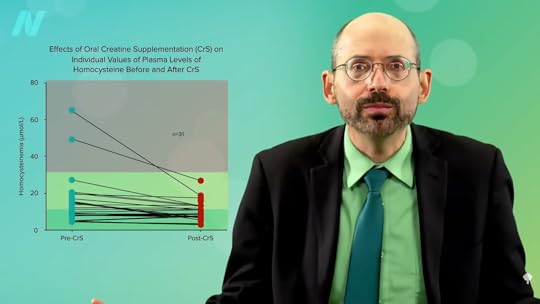
Now, they didn’t normalize, as that would have been a level under 10, but that’s presumably because they weren’t taking any B12. Give vegetarians and vegans vitamin B12 supplements, either dosing daily or once a week, and their levels normalize in a matter of months, as you can see below and at 2:20 in my video. However, the fact that you could bring down homocysteine levels with creatine alone, even without any B12, suggests—to me at least—that if your homocysteine is elevated (above 10) on a plant-based diet despite taking B12 supplements and eating greens and beans to get enough folate, it might be worth experimenting with supplementing with a gram of creatine a day for a few weeks to see if your homocysteine comes down.
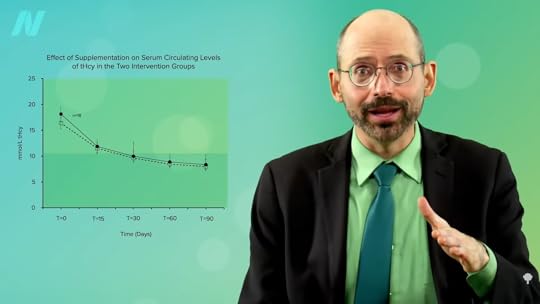
Why just a single gram? That’s approximately how much non-vegetarians do not have to make themselves; it’s the amount that erased vegetarian discrepancies in blood and muscle, as you can see in the graph below and at 3:01 in my video, and how much has been shown to be safe in the longer term.

How safe is it? We can take a bit of comfort in the fact that it’s “one of the world’s best-selling dietary supplements,” with literally billions of servings taken, and the only consistently reported side effect has been weight gain, presumed to be from water retention. The only serious side effects appear to be among those with pre-existing kidney diseases taking whopping doses closer to 20 grams a day. A concern was raised that creatine could potentially form a carcinogen known as N-nitrososarcosine when it hit the acid bath of the stomach, but, when it actually put to the test, researchers found this does not appear to be a problem.
Bottom line: Doses of supplemental creatine up to 3 grams a day are “unlikely to pose any risk,” provided “high purity creatine” is used. However, as we all know, dietary supplements in the United States “are not regulated by the US Food and Drug Administration and may contain contaminants or variable quantities of the desired supplement” and may not even contain what’s on the label. We’re talking about “contaminants…that may be generated during the industrial production.” When researchers looked at 33 samples of creatine supplements made in the United States and Europe, they found that they all actually contained creatine, which is nice, but about half exceeded the maximum level recommended by food safety authorities for at least one contaminant. The researchers recommend that “consumers give their preference to products obtained by producers that ensure the highest quality control and certify the maximum amount of contaminants present in their products.” Easier said than done.
Because of the potential risks, I don’t think people should take creatine supplements willy-nilly, but the potential benefits may exceed the potential risks if, again, you’re on a healthy plant-based diet and taking B12, and your homocysteine levels are still not under 10. In that case, I would suggest giving a gram a day of creatine a trying to see if it brings it down.
The reason I did this whole video series goes back to “Risks of Ischaemic Heart Disease and Stroke in Meat Eaters, Fish Eaters, and Vegetarians Over 18 Years of Follow-Up: Results from the Prospective EPIC-Oxford Study,” which found that, although the overall cardiovascular risk is lower in vegetarians and vegans combined, they appeared to be at slightly higher stroke risk, as you can see in the graph below and at 5:06 in my video.

I went through a list of potential causes, as you can see at 5:11 and below, and arrived at elevated homocysteine. What’s the solution? A regular, reliable source of vitamin B12. The cheapest, easiest method that I personally use is one 2,500 mcg chewable tablet of cyanocobalamin, the most stable source of B12, once a week. (In fact, you can just use 2,000 mcg once a week.) And, again, a backup plan for those doing that but still having elevated homocysteine is an empirical trial of a single gram a day of creatine supplementation, which was shown to improve at least capillary blood flow in those who started out with high homocysteine levels.
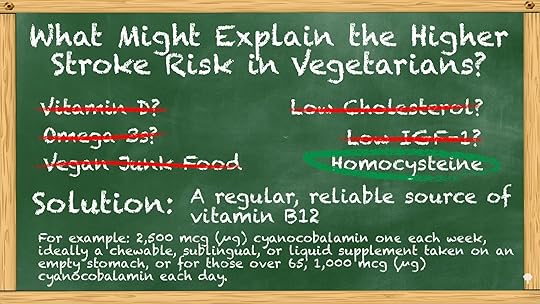
In sum, plant-based diets appear to “markedly reduce risk” for multiple leading killer diseases—heart disease, type 2 diabetes, and many common types of cancer—but “an increased risk for stroke may represent an ‘Achilles heel.’ Nonetheless, vegans have the potential to achieve a truly exceptional ‘healthspan’ if they face this problem forthrightly by restricting salt intake and taking other practical measures that promote cerebrovascular [brain artery] health…Nonetheless, these considerations do not justify nutritional nihilism. On balance, low-fat vegan diets offer such versatile protection for long-term health that they remain highly recommendable. Most likely, the optimal strategy is to adopt such a [plant-based] diet, along with additional measures—appropriate food choices, exercising training, judicious supplementation [of vitamin B12]—that will mitigate the associated stroke risk.” And try not to huff whipped cream charging canister gas. Leave the “whippets” alone.
This concludes my series on stroke risk. If you missed any of the other videos, see the related posts below.
I’m assuming that nearly everyone taking their B12 will have normal homocysteine levels, so these last two videos are just for the rare person who doesn’t. However, those on a healthy plant-based diet with elevated homocysteine levels despite taking sufficient vitamin B12 should consider taking a gram a day of contaminant-free creatine, which should be about a quarter teaspoon.
Where do you get contaminant-free creatine? Since regulations are so lax, you can’t rely on supplement manufacturers no matter what they say, so I would recommend going directly to the chemical suppliers that sell it to laboratories and guarantee a certain purity. Here are some examples (in alphabetical order) of some of the largest companies where you can get unadulterated creatine: Alfa Aesar, Fisher Scientific, Sigma-Aldrich, and TCI America.
September 12, 2024
Creatine to Normalize Homocysteine in Vegetarians?
What are the consequences of having to make your creatine rather than relying on dietary sources?
“Almost universally, research findings show a poor vitamin B12 status among vegetarians” because they aren’t taking vitamin B12 supplements like they should, which results in an elevation in homocysteine levels. This may explain why vegetarians were recently found to have higher rates of stroke, as you can see in the graph below and at 0:30 in my video Should Vegetarians Take Creatine to Normalize Homocysteine?.

Of course, plant-based eating is just one of many ways to become deficient in vitamin B12. Even nitrous oxide (laughing gas) can do it in as little as two days, thanks to the recreational use of whipped cream canister gas. (I just learned about “whippits”!)
When researchers gave vegetarians and vegans as little as 50 daily micrograms of cyanocobalamin, which is the recommended and most stable form of vitamin B12 supplement, their homocysteine levels, which had started up in the elevated zone, normalized right down into the safe zone under 10 mmol/L within only one to two months. Just 2,000 micrograms of cyanocobalamin once a week gave the same beautiful result, as you can see in the graph below and at 1:15 in my video.
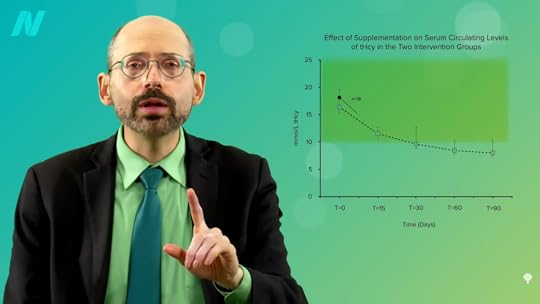
Not always, though. In another study, even 500 daily micrograms, taken as either a sublingual chewable or swallowable regular B12 supplement, didn’t normalize homocysteine within a month, as shown below and at 1:24. Now, presumably, if the participants had kept it up, their levels would have continued to fall as they did in the 50-daily-microgram study.

If you’re plant-based and have been taking your B12, but your homocysteine level is still too high (above 10 mmol/L), is there anything else you can do? Well, inadequate folate intake can also increase homocysteine, but folate comes from the same root as foliage. It’s found in beans and leaves, concentrated in greens. If you’re eating beans and greens, taking your B12, and your homocysteine level is still too high, I’d suggest taking 1 gram of creatine a day as an experiment, then getting your homocysteine levels retested in a month to see if it helped.
Creatine is a compound formed naturally in the human body that is primarily involved with energy production in our muscles and brain. It’s also formed naturally in the bodies of many other animals. So, when we eat their muscles, we can also take in some of the creatine in their bodies through our diet. We only need about 2 grams of creatine a day, so those who eat meat may get about 1 gram from their diet and their body makes the rest from scratch. There are rare birth defects where you’re born without the ability to make it, in which case, you have to get it from your diet. Otherwise, our bodies can make as much as we need to maintain normal concentrations in our muscles.
As you can see in the graph below and at 2:54 in my video, when you cut out meat, the amount of creatine floating around in your bloodstream goes down.

However, the amount in your brain remains the same, as shown in the graph below and at 2:57. This shows that dietary creatine doesn’t influence the levels of brain creatine, because our brain makes all the creatine we need. The level in vegetarian muscles is lower, but that doesn’t seem to affect exercise performance, as both vegetarians and meat eaters respond to creatine supplementation with similar increases in muscle power output. If vegetarian muscle creatine were insufficient, then presumably an even bigger boost would be seen. So, all that seems to happen when we eat meat is that our body doesn’t have to make as much. What does all of this have to do with homocysteine?

As you can see below and at 3:36 in my video, in the process of making creatine, our body produces homocysteine as a waste product. Now, normally this isn’t a problem because our body has two ways to detoxify it: by using vitamin B6 or a combination of vitamin B12 and folate. Vitamin B6 is found in both plant and animal foods, and it’s rare to be deficient. But, vitamin B12 is mainly found in animal foods, so its level can be too low in those eating plant-based who don’t also supplement or eat B12-fortified foods. And, as I mentioned, folate is concentrated in plant foods, so it can be low in those who don’t regularly eat greens, beans, or folic-acid-fortified grains. Without that escape valve, homocysteine levels can get too high. However, if you’re eating a healthy plant-based diet and taking your B12 supplement, your homocysteine levels should be fine.
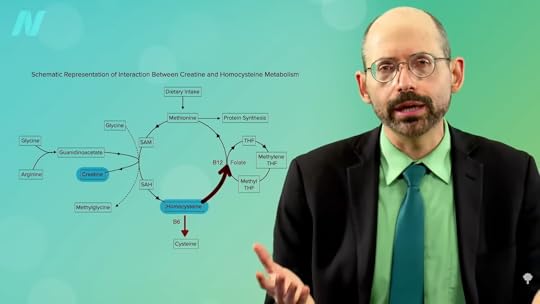
What if they aren’t? We might predict that if we started taking creatine supplements, our level of homocysteine might go down since we won’t have to make so much of it from scratch, producing homocysteine as a by-product, but you don’t know until you put it to the test. I’ll cover that next.
This is the eleventh in a 12-video series exploring stroke risk. If you missed the last two, see Vegetarians and Stroke Risk Factors: Vitamin B12 and Homocysteine? and How to Test for Functional Vitamin B12 Deficiency.
This whole creatine angle was new to me. I had long worried about homocysteine levels being too high among those getting inadequate B12 intake, but I didn’t realize there was another potential mechanism for bringing it down other than with vitamin B. Let’s see if it pans out in my final video of the series: The Efficacy and Safety of Creatine for High Homocysteine.
Creatinine to Normalize Homocysteine in Vegetarians?
What are the consequences of having to make your creatine rather than relying on dietary sources?
“Almost universally, research findings show a poor vitamin B12 status among vegetarians” because they aren’t taking vitamin B12 supplements like they should, which results in an elevation in homocysteine levels. This may explain why vegetarians were recently found to have higher rates of stroke, as you can see in the graph below and at 0:30 in my video Should Vegetarians Take Creatine to Normalize Homocysteine?.

Of course, plant-based eating is just one of many ways to become deficient in vitamin B12. Even nitrous oxide (laughing gas) can do it in as little as two days, thanks to the recreational use of whipped cream canister gas. (I just learned about “whippits”!)
When researchers gave vegetarians and vegans as little as 50 daily micrograms of cyanocobalamin, which is the recommended and most stable form of vitamin B12 supplement, their homocysteine levels, which had started up in the elevated zone, normalized right down into the safe zone under 10 mmol/L within only one to two months. Just 2,000 micrograms of cyanocobalamin once a week gave the same beautiful result, as you can see in the graph below and at 1:15 in my video.

Not always, though. In another study, even 500 daily micrograms, taken as either a sublingual chewable or swallowable regular B12 supplement, didn’t normalize homocysteine within a month, as shown below and at 1:24. Now, presumably, if the participants had kept it up, their levels would have continued to fall as they did in the 50-daily-microgram study.

If you’re plant-based and have been taking your B12, but your homocysteine level is still too high (above 10 mmol/L), is there anything else you can do? Well, inadequate folate intake can also increase homocysteine, but folate comes from the same root as foliage. It’s found in beans and leaves, concentrated in greens. If you’re eating beans and greens, taking your B12, and your homocysteine level is still too high, I’d suggest taking 1 gram of creatine a day as an experiment, then getting your homocysteine levels retested in a month to see if it helped.
Creatine is a compound formed naturally in the human body that is primarily involved with energy production in our muscles and brain. It’s also formed naturally in the bodies of many other animals. So, when we eat their muscles, we can also take in some of the creatine in their bodies through our diet. We only need about 2 grams of creatine a day, so those who eat meat may get about 1 gram from their diet and their body makes the rest from scratch. There are rare birth defects where you’re born without the ability to make it, in which case, you have to get it from your diet. Otherwise, our bodies can make as much as we need to maintain normal concentrations in our muscles.
As you can see in the graph below and at 2:54 in my video, when you cut out meat, the amount of creatine floating around in your bloodstream goes down.

However, the amount in your brain remains the same, as shown in the graph below and at 2:57. This shows that dietary creatinine doesn’t influence the levels of brain creatine, because our brain makes all the creatine we need. The level in vegetarian muscles is lower, but that doesn’t seem to affect exercise performance, as both vegetarians and meat eaters respond to creatine supplementation with similar increases in muscle power output. If vegetarian muscle creatine were insufficient, then presumably an even bigger boost would be seen. So, all that seems to happen when we eat meat is that our body doesn’t have to make as much. What does all of this have to do with homocysteine?

As you can see below and at 3:36 in my video, in the process of making creatine, our body produces homocysteine as a waste product. Now, normally this isn’t a problem because our body has two ways to detoxify it: by using vitamin B6 or a combination of vitamin B12 and folate. Vitamin B6 is found in both plant and animal foods, and it’s rare to be deficient. But, vitamin B12 is mainly found in animal foods, so its level can be too low in those eating plant-based who don’t also supplement or eat B12-fortified foods. And, as I mentioned, folate is concentrated in plant foods, so it can be low in those who don’t regularly eat greens, beans, or folic-acid-fortified grains. Without that escape valve, homocysteine levels can get too high. However, if you’re eating a healthy plant-based diet and taking your B12 supplement, your homocysteine levels should be fine.

What if they aren’t? We might predict that if we started taking creatine supplements, our level of homocysteine might go down since we won’t have to make so much of it from scratch, producing homocysteine as a by-product, but you don’t know until you put it to the test. I’ll cover that next.
This is the eleventh in a 12-video series exploring stroke risk. If you missed the last two, see Vegetarians and Stroke Risk Factors: Vitamin B12 and Homocysteine? and How to Test for Functional Vitamin B12 Deficiency.
This whole creatine angle was new to me. I had long worried about homocysteine levels being too high among those getting inadequate B12 intake, but I didn’t realize there was another potential mechanism for bringing it down other than with vitamin B. Let’s see if it pans out in my final video of the series: The Efficacy and Safety of Creatine for High Homocysteine.



